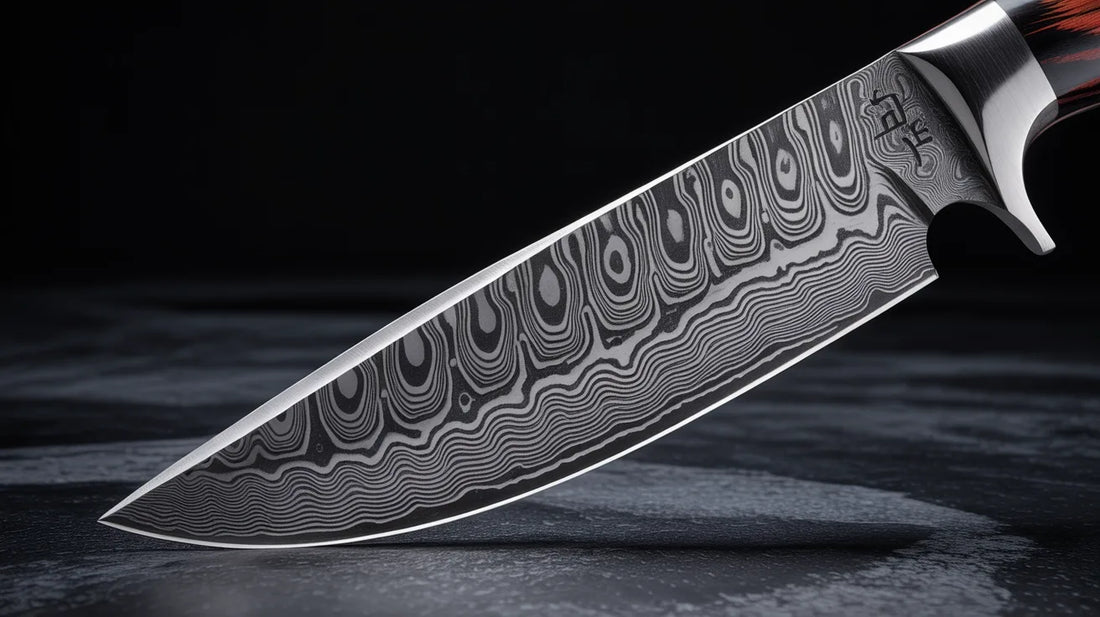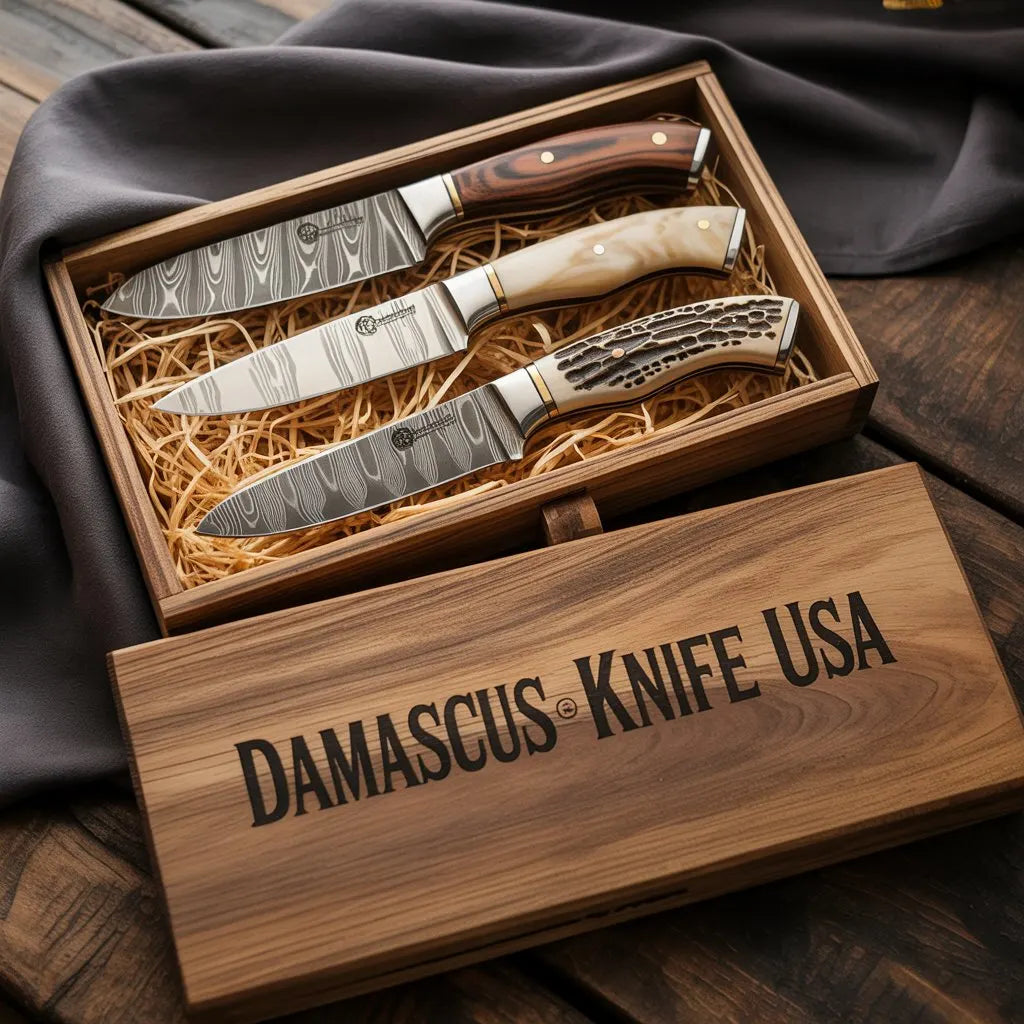For centuries, Damascus steel has fascinated warriors, craftsmen, and knife collectors alike. With its flowing, wave-like patterns that resemble smoke or rippling water, each blade carries a sense of artistry and history. These designs aren’t just for show—they’re a reflection of the meticulous forging techniques once used by skilled metalworkers.
What truly sets real Damascus steel apart is its balance of sharpness, strength, and visual beauty. But as interest in such blades has surged, so has the number of fakes available in the market. A lot of knives today have printed or etched designs that mimic the appearance but lack the structure and quality of the original craft.
If you're considering a Damascus knife, knowing how to tell the difference is more important than ever. Spotting fakes takes a trained eye—and a bit of background knowledge. In the sections below, we’ll explore how to recognize authentic Damascus steel so you don’t get fooled by cheap lookalikes.
What Is Damascus Steel?
Damascus steel is known for its eye-catching, wavy patterns that seem to ripple across the surface of a blade. But it’s not just about looks—this metal is also celebrated for its strength, durability, and ability to hold a sharp edge.
The origins of Damascus steel trace back to ancient times, with its roots believed to lie in India, where a type of high-carbon steel called wootz was first developed. This steel eventually made its way to the Middle East, particularly Syria, where it gained its now-famous name.
Creating traditional Damascus involved a labor-intensive forging process, where layers of iron and steel were repeatedly folded and forged together. The distinctive pattern appears naturally during this process and becomes more visible after acid etching, which highlights the contrast between the layered metals.
Historically, blades made from this material were prized for their performance in battle—strong enough to endure repeated use and sharp enough to slice with precision. Even today, Damascus steel remains popular among knife makers and collectors for its blend of performance, beauty, and historical significance.
Why Fake Damascus Steel Exists
As interest in Damascus steel has skyrocketed, so has the number of fakes flooding the market. With more collectors and knife enthusiasts looking for these eye-catching blades, some manufacturers have taken shortcuts to meet the demand—often at the expense of quality and blade authenticity.
Mass Production Tricks
To save time and cut costs, many mass producers use methods like:
- Laser etching, which adds patterning on the surface without any real layering
- Acid etching, which gives plain steel the appearance of Damascus without structural depth
- Chemical treatments, which simulate grain patterns that look convincing but are only cosmetic
Cosmetic vs. True Craftsmanship
Authentic Damascus steel is made by folding and forging layers of different metals over and over—a slow, skilled process that creates patterns running through the entire blade, not just on the surface.
Fake versions, on the other hand, rely on surface-level tricks. Techniques like laser burning or acid washes only add design to the outer layer, without altering the blade’s internal structure.
The appeal for sellers is clear: these imitations are cheap to produce and can be sold at premium prices to buyers who aren’t sure what to look for. Unfortunately, that leaves many customers paying top dollar for knives that lack the performance, history, and value of true Damascus steel.
7 Ways to Spot Genuine Damascus Steel
Finding a true Damascus blade means looking past the surface shine. Here are seven hands-on checks you can use to tell fake vs real Damascus before buying:
Visual Pattern Inspection
Real Damascus steel has flowing, organic lines—think rippling water or drifting smoke. These patterns are made by repeatedly forging and folding diverse steels together, so they bend and merge naturally. If its design looks too stamped on, uniform, or perfectly repeated, it is probably just printed or etched.
Cross-Section Check
Slice through your suspicion by examining the blade’s edge or any exposed steel (for example, at the tip). In an authentic billet, you’ll see the same layered pattern running from spine to edge. If the layers disappear or you spot weld seams, that’s a red flag.
Light, Angle, and Texture Test
Tilt the blade under a bright light. Real Damascus will show subtle depth where the layers catch the light differently—and you’ll feel a slight grain under your fingertips. Fake versions often look flat or glossy, with no sense of topography.
DIY Acid Etch Verification
(Only attempt this on a small, inconspicuous area!) Gently sand a tiny patch to remove the initial pattern, then dab on a mild acid solution (ferric chloride works). Wait for thirty to sixty seconds, wash, and neutralize using baking soda. On genuine Damascus, the pattern will reappear in that spot. If it stays blank or turns uniformly dark, it’s just surface treatment.
Price and Seller Reputation
Quality Damascus demands time and skill—so if a “Damascus” knife is shockingly cheap, beware. Cross-check seller reviews, ask where they source their steel, and compare prices with reputable brands. A deal that seems too good to be true frequently is.
Brand and Steel Specifications
Look for transparency. Trustworthy makers will list the exact steel types used (for example, 1095 and 15N20) and describe their folding/forging process. If the brand can’t—or won’t—tell you details about heat treatment, layer count, or origin, treat that as a warning sign.
Long-Term Wear and Performance
Finally, real Damascus earns its reputation over time. A genuine blade holds an edge longer, takes an even patina, and shows consistent patterning even after sharpening. Imitations may lose their “Damascus” look after a few hone sessions or reveal a plain steel core.
By combining these checks—visual cues, simple tests, and a bit of research—you’ll be far more likely to bring home an authentic Damascus knife rather than a pretty imposter.
Common Myths About Damascus Steel
There’s a lot of confusion and hype surrounding Damascus steel—and unfortunately, that leads many buyers and collectors down the wrong path. The following are a few of the most common myths. Let’s look at them:
1. The Pattern Fallacy
A swirling pattern on a blade doesn’t automatically mean it’s Damascus steel. That is one of the major myths out there. A lot of knives today have laser-printed or etched designs that mimic the appearance but do not reflect the actual forging procedure. True Damascus patterns are the result of layering and forging multiple types of steel together—they’re baked into the blade, not printed on top.
2. The Alloy Misunderstanding
Another common myth is that Damascus steel refers to a specific type of metal. In reality, it’s not about the alloy—it’s about the technique. Traditional Damascus was made using wootz steel, a high-carbon material from India. Modern Damascus, however, is typically made by welding and folding different types of carbon steel—often combinations like 1084 and 15N20.
3. The Invincibility Myth
Movies and legends often portray Damascus steel as nearly indestructible or even magical. While it’s true that a well-forged Damascus blade is incredibly durable, holds a sharp edge, and can flex under pressure, it’s not immune to damage. Just like any quality steel, it can chip, dull, or break if mistreated or poorly maintained.
Comprehending these myths assists in setting true expectations and makes it simpler to spot true quality. When you distinct fact from fiction, you are much more likely to find a blade that is worth the investment and one that performs stunningly for many years to come.
Why Real Damascus Steel Matters
Real Damascus steel stands out not just for its performance, but for what it represents—a rare blend of craftsmanship, history, and artistry. For those who appreciate both form and function, a genuine Damascus blade is more than just a tool; it’s a lasting investment.
Performance That Delivers
One of the biggest reasons Damascus steel is so highly regarded is its exceptional functionality. These knives are known for their ability to hold a sharp edge and resist corrosion, making them ideal for everything from everyday kitchen prep to demanding outdoor use. Whether you’re slicing vegetables, trimming meat, or skinning game, a well-made Damascus blade can handle the job with precision and reliability.
Aesthetic and Collector Appeal
Every authentic Damascus knife features a one-of-a-kind pattern that emerges during the forging process. Unlike mass-produced blades, no two look exactly alike—each has its own character. This uniqueness makes them especially appealing to collectors and enthusiasts. Their beauty and rarity not only add aesthetic value but also help them retain strong resale worth over time.
A Balance of Art and Function
When forged with skill and care, real Damascus steel offers the kind of performance and visual appeal that justifies its higher price tag. For serious users and collectors alike, it’s a material that represents quality, durability, and tradition—all rolled into one remarkable blade.
Frequently Asked Questions
Q: Is real Damascus steel expensive?
Yes, genuine Damascus steel is typically more expensive than standard knives. That’s because the forging process is labor-intensive, requiring skilled craftsmanship to fold and weld multiple layers of steel. Quality Damascus knives usually start around $200–$300, while premium, custom-made pieces can cost thousands.
Q: Can Damascus steel rust?
It can. The majority of genuine Damascus steel has high-carbon alloys, which are prone to corrosion if not maintained appropriately. For preventing rust, clean your blade after using, dry it carefully, and apply a light layer of oil. Stainless Damascus blades provide better corrosion resistance but might trade off a few traditional performance characteristics.
Q: Is etched Damascus real?
Not always. Some blades use surface etching to mimic the look of Damascus, but they don’t have the internal layered structure that defines the real thing. True Damascus patterns come from the forging process itself. Acid etching should enhance the existing layers—not create a fake design.
Q: Is it legal to sell fake Damascus?
Selling face Damascus as if it is genuine is contemplated deceiving and frequently violates customer protection laws. However, enforcement can differ relying on your region. That is why it is significant for purchasers to be knowledgeable and know how to find the difference.
Conclusion
Knowing how to tell real Damascus steel from a convincing fake is an essential skill for collectors, knife makers, and enthusiasts alike. By looking closely at details like pattern flow, layer consistency, surface texture, and how the blade responds to an acid test, you can confidently identify authentic craftsmanship.
Smart buyers go beyond surface beauty to evaluate the structure and technique behind the blade. True Damascus steel blends timeless artistry with high-level performance—where ancient forging traditions meet modern function.
At our store, we support both hobbyists and professional knife makers with high-quality abrasives and complete knife-making kits. Whether you're forging your own Damascus blades or learning how to spot a real one, we provide the tools and resources to help you create, refine, and care for exceptional knives.
With the right knowledge and materials, you’re not just buying or making a knife—you’re preserving a piece of history.


